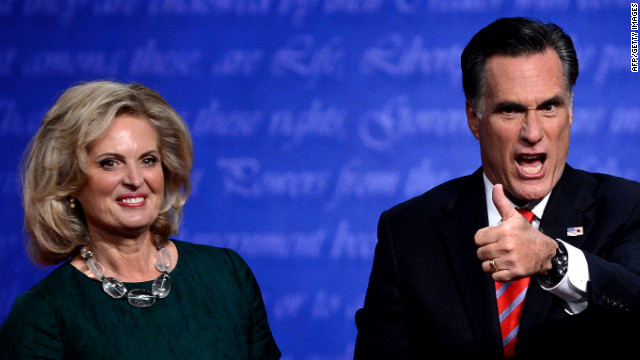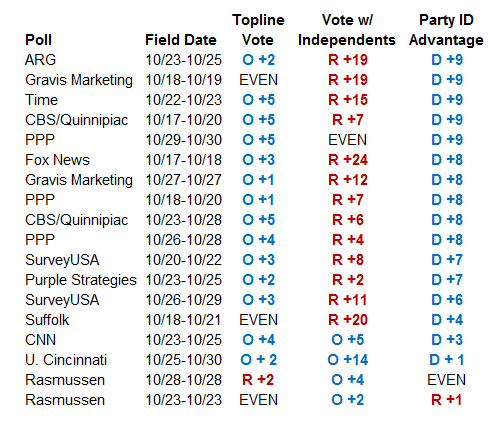My Election Prediction 2012 (270toWin)
During the primaries, I remember telling a friend of mine that if Romney was nominated, this election would look a lot like 2004.Turns out the similarities are striking. However, one of the most comical similarities is the denialism. In 2004, we had sites like the Donkey Rising Blog trying to explain away Bush's favorable numbers in the polls. Today we have sites like UnSkewed Polls doing the same thing to Obama's poll numbers, sometimes even projecting Romney will win in a near-landslide! However, the methods used to come up with these numbers are deeply flawed. But that hasn't stopped a number of pundits from giving similarly absurd projections:
- Michael Barone, The Examiner: Romney 315, Obama 223.
- George Will, The Washington Post: Romney 321, Obama 217.
- James Pethokoukis: Romney 301, Obama 227.
- Dick Morris, FoxNews: Romney 325, Obama 213.
- Jim Cramer, CNBC: Obama 440, Romney 98.
- Dean Chambers, UnskewedPolls.com: Romney 311, Obama 227.
Every one of these pundits is predicting a highly unlikely result. Other than Jim Cramer, each one predicts Romney picking up over 300 Electoral votes, meaning Obama would pick up at most 238 electoral votes. According to the RCP averages, this means the polls would have to be off by up to 4 points in some states! In the FiveThirtyEight model, such a thing would be historically unprecedented to an incredible degree! However, unlike Cramer's prediction, the FiveThirtyEight model at least holds this as a possibility, albeit an incredibly small one. One has to wonder why so many pundits are risking their credibility with such unbelievably unlikely predictions. Of course, one would also have to underestimate the level of cognitive dissonance some of these pundits have, as well as their fans.
I have to confess. Over the last couple of months, I have grown an unhealthy obsession with the polls. I have made trips to RealClearPolitics, Pollster, and FiveThirtyEight a regular habit. When I wake up in the morning to take the puppy out, I check the Rand Corporation's Daily Poll. Throughout the day, I check RCP for updates to the Rasmussen poll, the Gallup Poll, Investor's Business Daily, and ABC/Washington Post, as well as up to date averages of the state polls. I also make regular trips to Pollster to check on polls RCP doesn't factor in. I understand that you cannot cherry pick polls, that you have to account for house effects, and that you have to look at both the the national and state polls to get a clear picture of the race. As a result, I have mostly taken a break from blogging, preferring to post whatever thoughts I may have on Facebook rather than this blog, likely to the utter annoyance of all my friends. So before the election concludes tomorrow (hopefully), I thought I would put my own projection on the table (on the top of this page). Some explanations:
- Pennsylvania and Michigan: Despite Romney's recent play on Pennsylvania, the chances of him winning the state are extremely low: FiveThirtyEight gives Obama a 99% chance of taking the state. Other than the extremely right-leaning Susquehanna Poll, the most Romney-favorable polls still give Obama a comfortable 3 point lead. As Nate Silver has explained, this state is also incredibly inelastic, meaning there are rarely very many voters who will wait til the last minute to make a choice. In Michigan, the only poll giving Romney any chance is the Baydoun/Foster poll. Although this poll is classified as a Democratic pollster, its numbers in Michigan have been extremely favorable to Romney, meaning it has a larger than normal house effect. Nate Silver gives Obama a 100% chance of winning the state and Romney has not seriously contested it.
- Nevada: Although RCP only gives Obama a 2.8 percent lead here, Nevada polls have consistently underrated Democrats for the elections in 2008 and 2010, by large margins. Given the issues among pollsters with the Latino vote, as well as Harry Reid's superior ground game in the state, I doubt 2012 will be any different. Nate Silver also has Obama at a 94% chance of winning Nevada.
- Wisconsin and Ohio: Both of these states show small but persistent Obama leads. And neither state show any poll with a Romney lead. RCP has Obama up 2.9 points in Ohio and 4.2 points in Wisconsin. The distribution in Ohio has been very tight, despite the large number of polls conducted in the state. Wisconsin's distribution has been less so but it has also shown better numbers for Obama in its more Obama-favorable polls. However, both the polls showing strong Obama leads have been incredibly volatile over the course of this campaign. Nonetheless, Nate Silver gives Obama a 92% chance of carrying Ohio and a 97% chance of carrying Wisconsin.
- Iowa and New Hampshire: Both of these states have had very sporadic polling. But Obama is still favored in both. RCP has Obama up 2.4 points in Iowa and 2.0 points in New Hampshire. In addition, only two polls give Romney a lead in Iowa and none give him a lead in New Hampshire. The two polls that give Romney a lead in Iowa tend to have very Romney-favorable results, and their leads are only a point. At least one Romney-favorable poll also gives Obama a 4 point lead in Iowa. In addition, Iowa's only local poll gives Obama one of his best leads. The situation is similar in New Hampshire. Nate silver gives Obama a 86% chance of winning Iowa and an 86% chance of winning New Hampshire.
- Virginia and Colorado: Both of these states appear to be toss-ups, although Nate Silver marked them both as "Likely Obama" today. According to RCP, Obama has a 0.3% lead in Virginia and a 1.5% lead in Colorado. However, there are still a few polls giving Romney slight leads in each state. Although early voting in Colorado seems to be favoring Mitt Romney, Democrats have been closing the gap (we should see the final results of early voting tomorrow morning). Some polls that have asked about early voting show that Obama is expected to do better on election day than he has in early voting. Others show he is expected to do worse but may get better results tomorrow morning. But this may not matter. In 2008, Obama barely edged out McCain in early voting, yet still won the state by 8.6 percentage points, meaning historically the early voting trend may not be unprecedented in Colorado given that Obama will likely not win by 8.6 percentage points anyway. For the purposes of my projection, I predict Obama will carry Colorado, mainly because of the polls. Virginia is very close nationally, and it is hard to come by good early voting statistics for the state. Their only local poll has also been extremely volatile. Given Nate Silver's projection, as well as the RCP average, I give Obama the slight edge in the state. Update 11/6/12: Wow, I cannot believe I didn't notice this until now. I fell for the fallacy of equating registration advantage with candidate advantage in Colorado. I took a look at whatever polls I could and noticed that Democrats do not have the identity advantage in Colorado that they do in other states. It appears as though, although Democrats and Republicans seem tied in terms of party identity, Republicans hold a 2-3 point registration advantage over Democrats in these polls, suggesting Obama is leading big with both registered and identified Independents. Indeed PPP's cross-tabs suggest as much. As a result, it is entirely possible, even likely, that Obama is still winning the early vote in Colorado, even though registered Republicans are ahead.
- Florida: On the surface, this state appears to be even more of a toss-up than other states. RCP has Romney up 1.5 points, but FiveThirtyEight has Obama up 0.2 percentage points. In addition, this is a state where the inaccuracies in polling the Latino vote should make the final outcome more Obama-favorable than the polls suggest. However, the local polls are Romney's strongest polls, and local polls should be given more weight. As a result, I would buck the FiveThirtyEight model (just barely) and give Florida to Romney.
- North Carolina: RCP gives Romney a 3.0 point lead in this state and Nate Silver gives Romney a 72% chance of winning the state. Obama does have a significant lead in early voting, but the polls for North Carolina reflect the polls of Ohio, but in Romney's favor. Given the razor thin margin Obama won this state by in 2008, I seriously doubt Obama will win this state again in 2012.
So my final electoral vote prediction is Obama at 303 electoral votes and Romney at 235 electoral votes. I would expect the election to swing anywhere from Obama winning 281-257 to Obama winning 332-206. So let's see what happens!
Note: for early voting results, see here.


